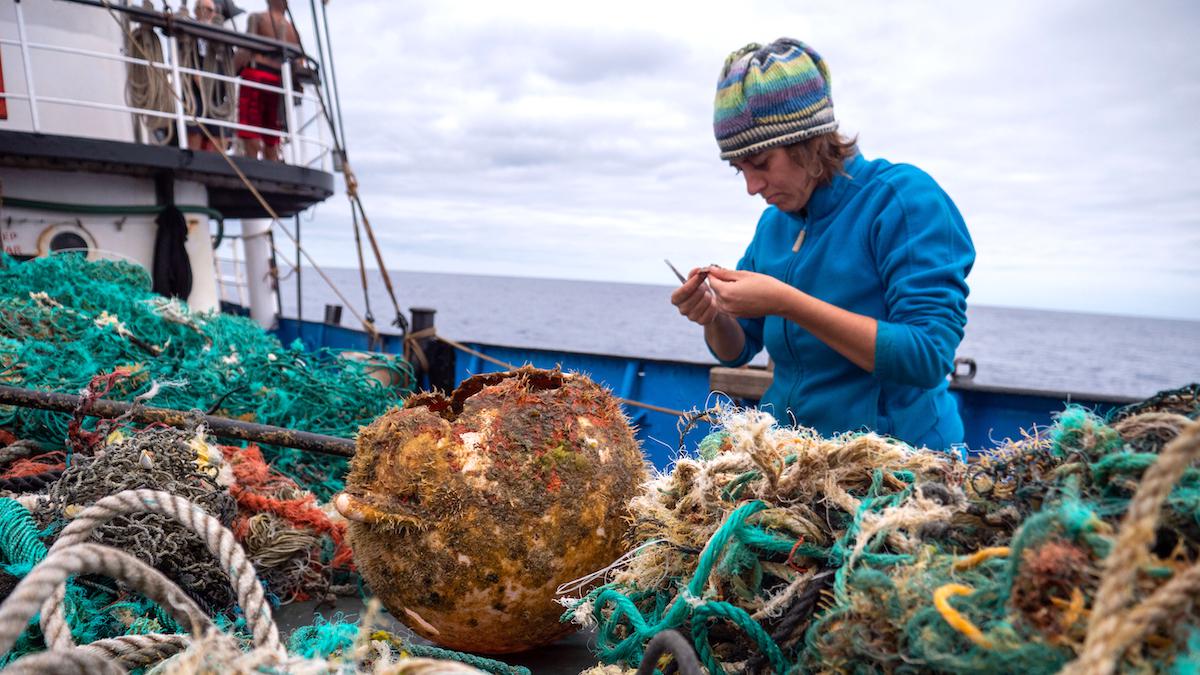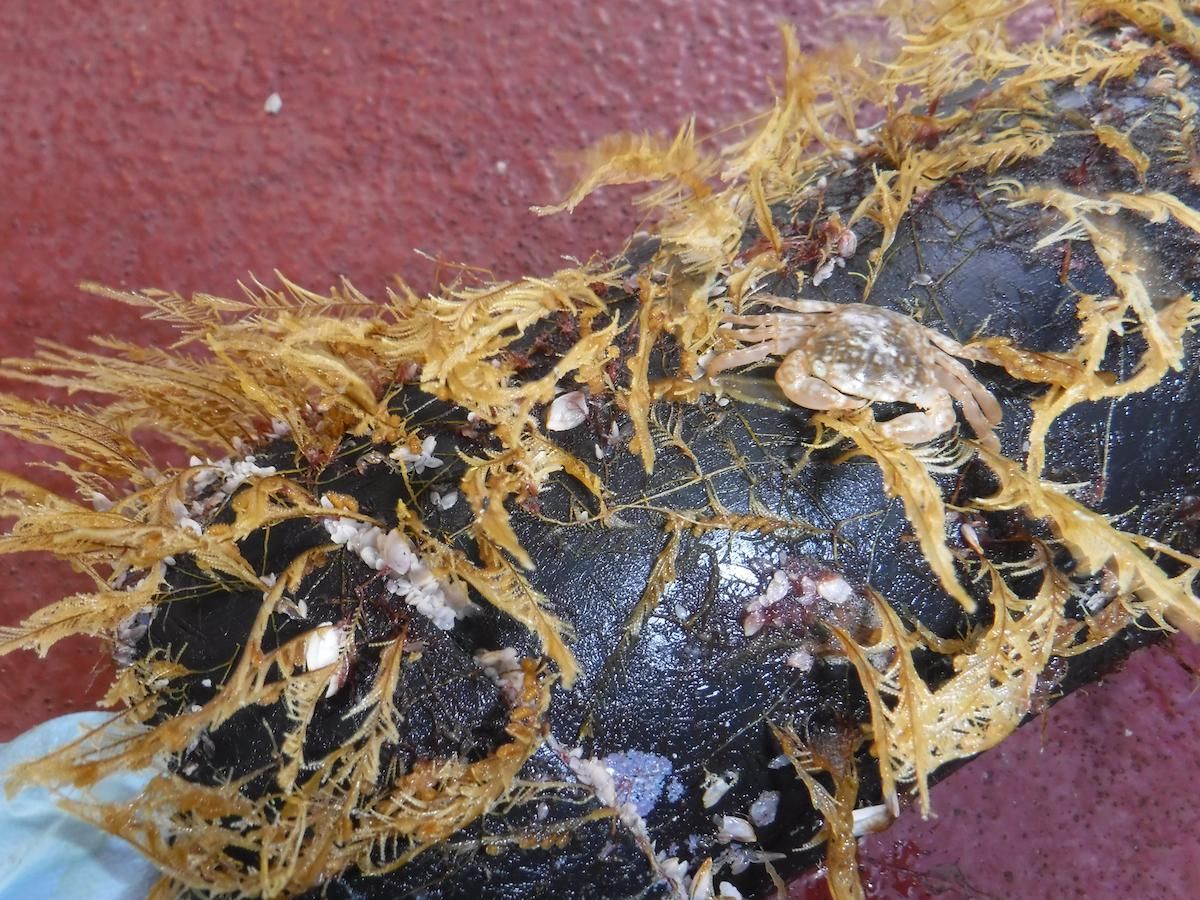
Great Pacific Garbage Patch Becomes an Ocean Habitat for Coastal Species

Anika Albrecht of Ocean Voyages Institute, on a 2020 expedition collecting plastic in the North Pacific Subtropical Gyre, where she served as chief mate. Ocean Voyages Institute 2020 Gyre Expedition
The North Pacific Subtropical Gyre, or the “Great Pacific Garbage Patch,” stretches for more than 610,000 square miles between California and Hawai’i. The gyre hosts around 79,000 metric tons of microplastics, nets, buoys and bottles. And, in a surprising turn, coastal life.
Scientists writing in Nature Communications Thursday have found coastal animals like anemones, hydroids and shrimp-like amphipods living on plastic collected from the open ocean.
“Floating plastic debris from pollution now supports a novel sea surface community composed of coastal and oceanic species at sea that might portend significant ecological shifts in the marine environment,” the study authors wrote.
Coastal species hitching rides across the open ocean is nothing new. This is, after all, how many plants and animals reach islands in the first place. However, in the past these animals could only travel on biodegradable rafts made from natural materials like trees and seaweed. That meant that coastal species could move from land mass to land mass, but not find a permanent home on the waves.

Coastal podded hydroid Aglaophenia pluma, open-ocean Planes crab and open-ocean Lepas gooseneck barnacles colonizing a piece of floating debris. Smithsonian Institution
That changed with the emergence of plastic pollution. There are currently 150 million metric tons of ocean plastic, and eight million metric more tons join them every year. The understanding of how this might provide new habitats for life emerged following the 2011 tsunami in Japan, which dumped about five million tons of debris into the ocean. Researchers discovered coastal species thriving on that debris when it washed up on the North American Pacific coast and the Hawaiian Islands. These species didn’t just survive for years while travelling more than 6,000 kilometers (approximately 3,728 miles), they also grew and reproduced in transit.
“This discovery demonstrated that anthropogenic debris, which was largely composed of floating plastics, provided long-lived, habitable rafts and exceeded our expectations of coastal species survival at sea,” the study authors wrote.
To investigate this further, Linsey E. Haram and Gregory M. Ruiz from the Smithsonian Environmental Research Center teamed up with University of Hawai‘i at Manoa oceanographers Jan Hafner and Nikolai Maximenko and plastic-collection nonprofit the Ocean Voyages Institute.
First, Hafner and Maximenko created a model that predicted where plastic was most likely to turn up in the Great Pacific Garbage Patch. Then, the Ocean Voyages Institute used that information to collect a record 103 tons of plastic and other debris from the garbage patch. They sent the debris to Haram in her lab, where she analyzed them and found several coastal species.
The permanent presence of coastal species in the open ocean is a big deal.
“The open ocean has not been habitable for coastal organisms until now,” Ruiz said in a press release emailed to EcoWatch.
The researchers called the new communities of life they discovered on the garbage patch neopelagic communities (neo for new and pelagic for open ocean). And they still have many questions about what this means for ocean life. For one thing, there are already ecosystems that live in the open ocean, which the coastal arrivers could potentially disrupt.
“Coastal species are directly competing with these oceanic rafters,” Haram said in the press release. “They’re competing for space. They’re competing for resources. And those interactions are very poorly understood.”
Further, the new species could travel on the plastic to other coasts, including vulnerable islands and protected areas, once again potentially competing with the species already there.
The researchers do not know how widespread these communities really are and whether they have found a home in the other four garbage gyres. But they do represent a new way that marine plastic pollution impacts marine life.
“The issues of plastic go beyond just ingestion and entanglement,” Haram said in the press release. “It’s creating opportunities for coastal species’ biogeography to greatly expand beyond what we previously thought was possible.”
- Great Pacific Garbage Patch Is Now Twice the Size of Texas ...
- Ocean Plastic: What You Need to Know - EcoWatch
- What Will It Take to Clean Up the Great Pacific Garbage Patch ...
- Whales and Dolphins Found in the Great Pacific Garbage Patch for ...

 233k
233k  41k
41k  Subscribe
Subscribe 